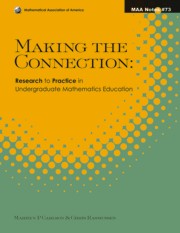Book contents
- Frontmatter
- Preface
- Contents
- Part 1 Student Thinking
- 1a Foundations for Beginning Calculus
- 1b Infinity, Limit and Divisibility
- 5 Developing Notions of Infinity
- 6 Layers of Abstraction: Theory and Design for the Instruction of Limit Concepts
- 7 Divisibility and Transparency of Number Representations
- 1c Proving Theorems
- 8 Overcoming Students' Difficulties in Learning to Understand and Construct Proofs
- 9 Mathematical Induction: Cognitive and Instructional Considerations
- 10 Proving Starting from Informal Notions of Symmetry and Transformations
- 11 Teaching and Learning Group Theory
- 12 Teaching for Understanding: A Case of Students' Learning to Use the Uniqueness Theorem as a Tool in Differential Equations
- Part 2 Cross-Cutting Themes
- About the Editors
9 - Mathematical Induction: Cognitive and Instructional Considerations
from Part 1 - Student Thinking
- Frontmatter
- Preface
- Contents
- Part 1 Student Thinking
- 1a Foundations for Beginning Calculus
- 1b Infinity, Limit and Divisibility
- 5 Developing Notions of Infinity
- 6 Layers of Abstraction: Theory and Design for the Instruction of Limit Concepts
- 7 Divisibility and Transparency of Number Representations
- 1c Proving Theorems
- 8 Overcoming Students' Difficulties in Learning to Understand and Construct Proofs
- 9 Mathematical Induction: Cognitive and Instructional Considerations
- 10 Proving Starting from Informal Notions of Symmetry and Transformations
- 11 Teaching and Learning Group Theory
- 12 Teaching for Understanding: A Case of Students' Learning to Use the Uniqueness Theorem as a Tool in Differential Equations
- Part 2 Cross-Cutting Themes
- About the Editors
Summary
The principle of mathematical induction (MI) is a prominent proof technique used to justify theorems involving properties of the set of natural numbers. The principle can be stated in different, yet equivalent, versions. The following are two versions common in textbooks:
Version 1: Let S be a subset of ℕ (the set of natural numbers). If the following two properties hold, then S = ℕ.
(i) 1 ∈ S.
(ii) k ∈ S, then k +1 ∈ S.
Version 2: Suppose we have a sequence of mathematical statements P(1),P(2),… (one for each natural number). If the following two properties hold, then for every n ∈ ℕ, P(n) is true.
(i) P(1) is true.
(ii) If P(k) is true, then P(k + 1) is true.
Poincaré, among others, viewed the principle of MI as intrinsic to humans' intuition: “Mathematical induction … is … necessarily imposed on us, because it is … the affirmation of a property of the mind itself” (Poincaré, 1952). In fact, historical documents indicate that mathematicians employed this method of proof for at least 200 years before it was explicitly formulated by Peano. Despite its intuitive appeal and its central role within mathematics, research in mathematics education has documented that students have major difficulties understanding MI (Dubinsky, 1986; Fischbein & Engel, 1989; Movshovitz-Hadar, 1993; Reid, 1992; Robert & Schwarzenberger, 1991; Harel, 2001; Brown, 2003).
In this chapter, we explore students' difficulties with MI when taught with the standard instructional treatment and we present results from our teaching experiments, which employed alternative instructional approaches.
- Type
- Chapter
- Information
- Making the ConnectionResearch and Teaching in Undergraduate Mathematics Education, pp. 111 - 124Publisher: Mathematical Association of AmericaPrint publication year: 2008
- 4
- Cited by

